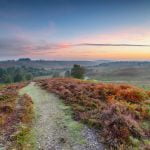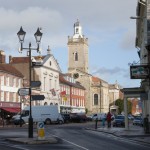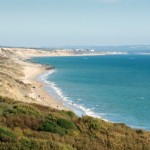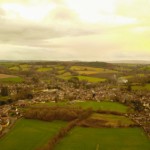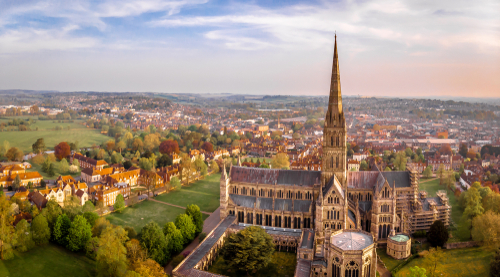
A quick guide to Salisbury
Salisbury is the second-largest settlement and the only city in the county of Wiltshire. Situated in the southwest of England on the edge of Salisbury Plain, it also lies at the confluence of three rivers; the Avon, Nadder, and Bourne. The city is situated approximately 20 miles (32 km) northwest of Southampton and 30 miles (48 km) southeast of Bath. Salisbury is arguable best known for its strong ecclesiastical heritage and being the nearest large township to the UNESCO World Heritage Site of Stonehenge. At the 2011 national census, the population of Salisbury was 40,302.
A Fleeting History
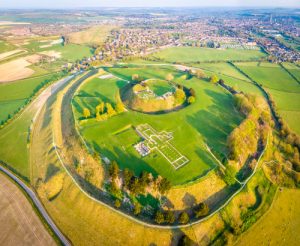
An aerial view of today’s Old Sarum
The story of Salisbury begins around 400 BC when an Iron Age Hillfort was built at the intersection of two trade paths about 2 miles (3 km) north of the modern-day city. The Romans took over the fort when they arrived in the mid-first century and went on to name it Sorbiodūnum. The Romans continuously occupied the site until they left Britain at the beginning of the 5th century. The Saxons took possession of the fort from the native Celts in the 6th century and would later use it as a stronghold against the marauding 8th century Vikings. Around 1070, the invading Normans constructed a motte and bailey castle at the site that was now known as Old Sarum. In 1075, Herman was ordained as the first Bishop of Salisbury and immediately commissioned the building of a cathedral. It was completed in 1092 but it was reported to have suffered serious storm damage only 5 days later.
The Old Sarum area became a firm favourite of Henry I who built a hunting lodge there around 1130. Both Henry II and Henry III invested heavily in the Lodge and by the mid-13th century, it had been converted to a royal residence, Clarendon Palace. In 1220, construction on a new Cathedral began as a replacement for that at Old Sarum, which had fallen into a state of considerable disrepair. The new bishop, Richard Poore, commissioned the cathedral to be built at a site on his estate at Old Salisburies. The foundation stone for the cathedral was laid by the Bishop but it would be another 38 years before the momentous structure was to be completed. Soon a new settlement grew up around the site of the cathedral, which became known as ‘New Sarum’, or sometimes as ‘New Saresbyri’.
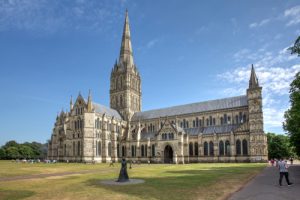
Salisbury Cathedral dates from 1220
By 1219, New Sarum had a market and an annual fair, and, in 1227, it received a city charter from King Henry III. In 1244, a stone bridge built across the River Avon increased traffic flow into the city. It soon became a popular stopover for travellers, particularly for those on the journey between Exeter and London. It was at this time that Franciscan and Dominican monks arrived in the city. The main industry in the city was now the production of woolen cloth, much of which was exported through Southampton. In 1344, the tower and spire were added to the cathedral. In 1425, the House of John A’Port, the mayor of the time, was built in Queen Street.
Post Middle Ages
By the mid-15th century, the city had grown to become one of the largest settlements in England with an estimated population of about 8,000. In 1539, Salisbury’s two priories were closed under Henry VIII’s Dissolution of the Monasteries Act. Between the mid-16th and early 17th century, Salisbury like many parts of England suffered from a series of outbreaks of the bubonic plague which resulted in a population decline. Still, in 1612, Salisbury was awarded a new city charter. Even so, it was during the 17th century that the city’s wool industry began to decline.
In 1642, the English Civil War first broke out between king and parliament but the city managed to avoid conflict for more than 2 years. That was until October 1644, when a Royalist army invaded the city. However, the king’s army was defeated only 2 months later by parliamentary forces. In January 1645, the situation was reversed once again by another Royalist attack. This saw Salisbury remain in Royalist’s hands until January 1646, when on the verge of defeat nationally, the king’s army withdrew. In 1655, a royalist uprising broke out in the West Country, which become known as Penruddock’s Rebellion. The people of Salisbury mostly chose to stay home and the insurgents where were soon crushed. Seven of the rebels were hanged in Salisbury with others being transported to the West Indies. The leader of the revolt, John Penruddock, was eventually beheaded.
By 1700, the once large and important Salisbury of the Middle Ages had regressed to its new status as a medium-sized market town. And, while cloth manufacture was still the city’s main industry, it continued to gradually decline. In 1701, one of Salisbury’s most renowned buildings, the eponymous Mompesson House, was built for merchant Charles Mompesson. Salisbury saw its first newspaper published in 1715.
In 1723, there was a smallpox outbreak in Salisbury, pushing public health up the priority list. In 1737, a special Act of Parliament meant that Salisbury became the first provincial town in England to have an authority, the ‘Directors of Highways’, who were responsible for street cleaning and maintenance. In 1774, an infirmary was built in the city, further contributing to the townsfolk’s well being.
By 1801, Salisbury had a population of 7,668, a fair-sized township of the time. However, Salisbury’s population grew little in the first half of the 19th century, such as by 1851, it was still less than 9,500. The Industrial Revolution that had transformed much of Britain, largely passed Salisbury by – it remained a market town. By this time, the once flourishing wool cloth industry, had died a death.
Nonetheless, Salisbury continued to see improvements during the 19th century. In 1833, the city gained gas street lighting, in 1836, a regular police force, and in 1847, the railway arrived. In the 1850s, the city got sewers and a piped water supply. In 1860, Salisbury museum was founded. In 1882, with the old settlement of Old Sarum in total ruin, the site was converted to a public park. In 1892 a public swimming pool opened. The second half of the 19th century saw rapid population growth in the city, such that by 1901 it had reached around 17,000.
The Modern Era
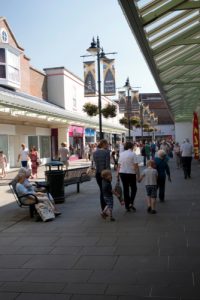
Downtown Salisbury 2020
In the 20th century Salisbury continued to develop but remained largely reliant on agriculture. The city’s first cinema opened in 1908. In the 1920s and 1930s slums were demolished and replaced by new council houses. After WW2, more council houses were built.
In 1968 Salisbury got its first shopping centre when the Old George Mall was opened. A new library opened in Salisbury in 1975 and a swimming pool in 1976. In 1982, the Duke of Edinburgh opened the then named Duke of Edinburgh’s Royal Regiment Museum. In 1986, the Maltings Shopping Centre opened, and in 1998, the Wilton Shopping Village.
Today, Salisbury’s economy is heavily made up of the service, retail, and tourist sectors.
Salisbury is twinned with Saintes, France, and Xanten, Germany.
Getting To Salisbury
By Road
There are multiple ways of getting to Salisbury. From London, it’s probably easiest to take the M3, then the M27, and finally the A36, which takes you directly to Salisbury. Alternatively, you could take the M3, A303 and then the A338. The A36, passing through Salisbury, connects Southampton and Bath, then on to Bristol via the A4. The A354 connects Salisbury with Dorset, while the A345 runs from Salisbury to Marlborough via Amesbury.
By Train
It’s easy to get here by train as it is served by two major mainline routes. Salisbury lies on the route between Waterloo Station, London and Exeter with a journey time of 90 minutes to London. It also lies on the Portsmouth to Cardiff route, also making it convenient for travel from the south coast and major cities such as Bristol and Bath.
By Bus
There are regular National Express coach services to Salisbury from London Victoria Station, Heathrow airport, Gatwick airport, Bath, Bristol and the Midlands.
By Air
The nearest airport to Salisbury is Bournemouth (BOH) which is around 25 miles away. The nearest large airport is Bristol (BRS) which is 59 miles, while London Heathrow (LHR) is 71 miles.
Notable People

TV actor & personality was born in Salisbury
A few notable people that were born or have lived in Salisbury include:
- Sir Edward Heath, KG, MBE (1916 – 2005) – better known as Ted Heath, served as an MP from 1950 to 2001, Leader of the Conservative Party from 1965 to 1975, and as PM from 1970 to 1974. He lived in Salisbury from 1985 to his death in 2005.
- David Mitchell – is a comedian, actor, writer and television & radio presenter, who was born in Salisbury in 1974.
- Michael Patrick Smith, CBE – is much better known by his stage name of Michael Crawford. He’s a multi-award winning and internationally renowned actor, comedian, stuntman, singer, and voice artist, who was born is Salisbury in 1942.
- Thomas Kerridge – is an English Michelin-starred chef who is well known UK television personality and presenter. Better known as ‘Tom’, he was born in Salisbury in 1973.
Did you know?
-
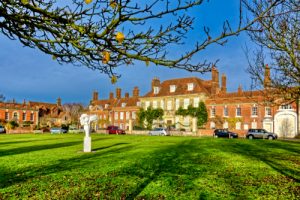
Mompesson House has been a period film location
The 18th century stately home Mompesson House located in Cathedral Close was a main filming location for Ang Lee’s 1995 film adaptation of Jane Austen’s ‘Sense and Sensibility’.
- Salisbury’s Cathedral’s spire clock was installed in 1386 and is recognised as the oldest working mechanical clock in the world.
- On 4 March 2018, that former Russian Intelligence Officer and double agent Sergei Skripal and his daughter Yulia Skripal were poisoned in Salisbury with the nerve agent Novichok. The 2 main suspects responsible for the attack have been identified as officers of the Russian Intelligence Service. Both Sergei and Yulia Skripal survived but have since been given new identities.
- Salisbury’s official name was still that of ‘New Sarum’ up until 2009.
Sport
Salisbury FC
Salisbury Football Club was formed in 2015 after the liquidation of Salisbury City FC. The club, nicknamed ‘The Whites’, currently play in the Southern League Premier Division South. The club play its home games at ‘The Raymond McEnhill Stadium’, which has an official capacity of 4,000.
Salisbury RC
Salisbury Rugby Club currently (2020) play in South West Division 1 East. The club are based at Hudson’s Field, Castle Road and are nicknamed ‘The Green and White’.
Things to do and see!
Just some of the things to see and do in and around Salisbury, includes:
- Salisbury Cathedral – Completed in 1258, its one of the most visited religious sites in England. It’s rated by many as the best example of early English Gothic style in the country. The cathedral’s chapterhouse houses one of the four original copies of the Magna Carta.
- Old Sarum – is a set of ruins that includes the old cathedral and William the Conqueror’s castle. It lies 2 miles to the north of the city centre on a hill that has been fortified since the Iron Age.
- Salisbury Museum – houses a great variety of permanent displays and special exhibitions throughout the year that tells the history of England, particularly Wiltshire. The Wessex Gallery houses a vast archaeological collection.
- Stonehenge – the UNESCO World Heritage Site is arguably the UK’s most renowned historic site. The 4,500 years old collection of huge Neolithic stones are located about 10 miles from Salisbury. There’s also interactive displays and replica Neolithic homes, as well as a café and a shop.
- Wilton House – is a Baroque-style mansion that was built in 1653. It was designed by famed architect of the time, Inigo Jones, to replace the original Tudor house which was destroyed by fire. The house is encompassed by a large ancient woodland area.
- Cathedral Close – is an 80-acre site that accommodates a number of grand houses and museums that date between the 1200s to the 1900s.
- Arundells – is the former home of British Prime Minister Edward (Ted) Heath, who died in 2005. Located in Cathedral Close the house dates back to the late 13th century. There’s an organised one-hour tour of the house. There are also attractive gardens which can be visited in the spring and summer months.
- Cholderton Charlie’s Rare Breeds Farm – is exactly what it says – a farm with rare animal breeds, such as goats, pigs, chickens, ponies and sheep that date back hundreds of years. Children can get an opportunity to feed the animals. There’s also a nature trail, water gardens, a picnic area, a children’s adventure playground, a restaurant and a gift shop.
- Boscombe Down Aviation Collection – is located in a hangar at Old Sarum airfield, less than 3 miles from Salisbury. The exhibition is a collection of post WW2 military aircraft and their weapons, which includes the likes of a Hunter F6, Sea Harrier, Jet Provost T4, Wasp HAS1, and Meteor MK D16, Sidewinder missiles, cluster bombs, etc.
- The Rifles Berkshire and Wiltshire Museum – tells of the infantry regiment’s history from the Seven Years War (mid-18th century) to the present day. There’s also a restaurant and a pleasant garden at the site.
- Mompesson House – is an early 18th-century grand townhouse located in Cathedral Close. The Grade I listed building and fine gardens, which has a tea-room and shop, is owned by the National Trust
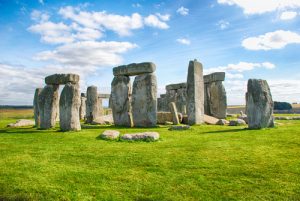
Stonehenge is regarded as the UK’s most famous historical site
Where to stay?
Considering its size, there’s a decent amount of accommodation in and around the city centre. A rough guide to prices per night for 2 adults sharing is:
B & B/Guesthouse/Inn £50 – 75
Hotel: £75 – 100
Luxury Hotel: £100 +
There’s also some holiday lets and apartments which vary in price depending on standard and location.
Moving to Salisbury?
Thinking of moving to here? The average property price in the Salisbury area for July 2020 stood at approximately £333,300. This represents a fall of almost 1.5 % on the average price paid in the last 12 months. In terms of property types, flats were selling for an average of £177,800, terraced houses for £252,300 and semi-detached for £307,000.
Photo Credit: Andrew Harker/Feature Flash Photo Agency/Shutterstock.com
